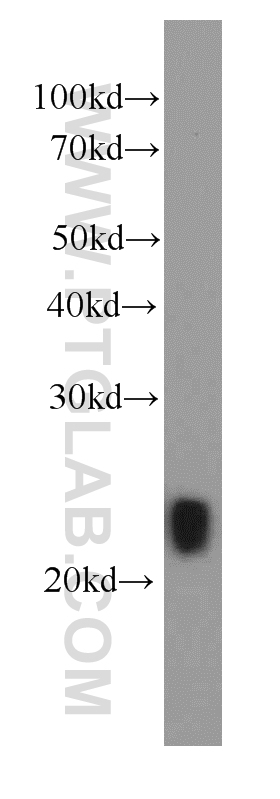验证数据展示
经过测试的应用
| Positive WB detected in | Recombinant protein |
推荐稀释比
| 应用 | 推荐稀释比 |
|---|---|
| Western Blot (WB) | WB : 1:5000-1:50000 |
| It is recommended that this reagent should be titrated in each testing system to obtain optimal results. | |
| Sample-dependent, Check data in validation data gallery. | |
产品信息
66163-1-Ig targets IL-29 in WB, ELISA applications and shows reactivity with human samples.
| 经测试应用 | WB, ELISA Application Description |
| 经测试反应性 | human |
| 免疫原 | IL-29 fusion protein Ag12444 种属同源性预测 |
| 宿主/亚型 | Mouse / IgG1 |
| 抗体类别 | Monoclonal |
| 产品类型 | Antibody |
| 全称 | interleukin 29 (interferon, lambda 1) |
| 别名 | Cytokine Zcyto21, IFN lambda 1, IFNL1, IL 29, IL29, IL-29, Interferon lambda 1, Interleukin 29, ZCYTO21 |
| 计算分子量 | 200 aa, 22 kDa |
| 观测分子量 | 22 kDa |
| GenBank蛋白编号 | BC074985 |
| 基因名称 | IL-29 |
| Gene ID (NCBI) | 282618 |
| RRID | AB_2881559 |
| 偶联类型 | Unconjugated |
| 形式 | Liquid |
| 纯化方式 | Protein G purification |
| UNIPROT ID | Q8IU54 |
| 储存缓冲液 | PBS with 0.02% sodium azide and 50% glycerol , pH 7.3 |
| 储存条件 | Store at -20°C. Stable for one year after shipment. Aliquoting is unnecessary for -20oC storage. |
背景介绍
Interleukin-29 (IL-29) is a cytokine belonging to the Type III interferon family, which has another two subfamilies IL-28A and IL-28B. They are also known as IFN-λ1, IFN-λ2 and IFN-λ3, respectively. IL-29 is produced predominantly by maturing dendritic cells and macrophages. IL-29 plays an important role in the immune response against pathogenes and especially against viruses by mechanisms similar to type I interferons. IL-29 receptor signals through JAK-STAT pathways leading to activated expression of interferon-stimulated genes and production of antiviral proteins.
实验方案
| Product Specific Protocols | |
|---|---|
| WB protocol for IL-29 antibody 66163-1-Ig | Download protocol |
| Standard Protocols | |
|---|---|
| Click here to view our Standard Protocols |
